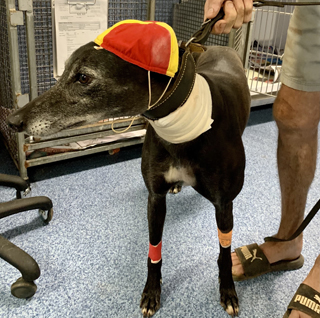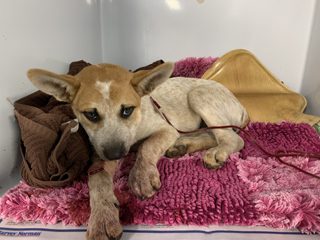Raymond

Photo by Dr. Duncan McGinness
Raymond, a retired racing greyhound, provides blood at Duncan McGinness Veterinary Surgeon in Dubbo for patients with anticoagulant rodenticide toxicosis. Raymond sports the distinctive cap worn by Australian lifeguards on beach patrol, colloquially called lifesavers.
Dogs and cats in Australia are being poisoned in large numbers by rodent bait, leading many to require blood transfusions as a severe mouse plague blights the country's eastern states.
The magnitude of the problem is so great in worst-hit regions that some veterinarians fear running short of donor blood. Others have struggled intermittently with obtaining enough vitamin K, a clotting agent, to treat a flow of victims that started intensifying late last year and shows no sign of let-up.
At least hundreds, but more likely thousands, of pets are becoming ill after eating rodent bait or ingesting mice that have eaten bait, according to veterinarians contacted by the VIN News Service. Bait with anticoagulants impedes clotting, potentially causing victims to bleed to death if not treated within several days of ingestion.
Treatment options range from induced vomiting for cases caught early to the administration of vitamin K in moderate to severe cases. Plasma or whole blood transfusions are needed for the more serious cases. "We've done so many blood transfusions, it's hard to keep count," said Dr. Anne Cusack, a practitioner at a veterinary hospital in Gunnedah, in northeastern New South Wales.
Cusack estimates her clinic alone has performed roughly 100 blood transfusions since December, and other clinics in the region "are dealing with the same problem," she said.
Some 250 kilometers (155 miles) away in Dubbo, Dr. Caitlyn Tremble said the clinic where she works ran 244 clotting tests between January and April. The vast majority indicated deficiencies.
The clinic has gone through 65 bags of plasma in the past four months — using about one bag per patient, she said, while about 10 patients have needed whole blood transfusions. Plasma replaces clotting factors, whereas whole blood replaces clotting factors as well as red blood cells, which carry oxygen.
"We're pretty lucky in that we have an arrangement with a gentleman who has retired greyhounds, so we have them on standby as a blood supply," Tremble said.
Cusack and her colleagues in Gunnedah don't have that luxury, and are asking all clients who have larger dogs for blood. "It seems as soon as we've collected the blood, we've used it up," she said.
Practitioners are treating far more dogs than cats. Tremble suspects that dogs are more likely to eat bait and dead mice, whereas felines tend to chase live mice. Still, she's seeing an increasing number of sickened cats come into the practice in Dubbo, one of which was given a transfusion of dog blood.
Homes invaded, crops destroyed
Dubbo and Gunnedah, which have at least eight veterinary clinics between them, are just two among dozens of Australian towns hit hard by the mouse plague. The most severe infestations are occurring in rural parts of central, western and northern New South Wales (NSW) and southern parts of Queensland. But elevated mice populations also have been detected in southern NSW and in states including Victoria, Western Australia and South Australia.
The Bega and Cobargo Veterinary Hospitals, for instance, are located on the south coast of NSW, but still are seeing at least one or two suspected rodent poisoning cases per day, according to operations manager Raelene Flower.
The mouse plague is driven by an end to drought conditions, allowing for bumper crops that provide plenty of food and shelter for mice, according to Steve Henry, a research officer at the Commonwealth Scientific and Industrial Research Organisation, or CSIRO, Australia's chief scientific agency.
Henry said mouse population explosions hit Australia roughly once a decade; the last was in 2010 and 2011. He isn't sure how many mice are involved this time or how the latest plague compares with others. "Once you've got farmers losing entire crops, it doesn't really matter precisely how many mice there are," he said.
Residents of affected towns tell hair-raising stories of mice swarms blanketing fields and roads, or regularly popping up inside homes and businesses. Tremble said one of her veterinarian colleagues had to take her car to a mechanic because mice had gotten under the bonnet and gnawed through tubing, including the radiator hose. Local roads are littered with the bodies of mice squashed by cars.
"There was a time when you'd walk into a restaurant and see a mouse and be, like, 'That's disgusting. I'm never coming back here,' " Tremble said. "But you see one now, and you think, 'Of course they've got mice. Everyone does.' "
The mice are decimating freshly planted crops, prompting farmers in NSW last week to ask lawmakers for AU$25,000 (US$19,485) for each business to help them buy more mouse bait. "Farmers and rural communities are still in the midst of combating a ceaseless mouse plague that is continuing to impact the northern and central west regions [of NSW] and rapidly spreading and growing through the south," Matthew Madden, chair of the NSW Farmers Association's grains committee, said in a statement.
A survey of association members showed some 30% of respondents had already each spent between AU$20,000 and AU$150,000 (US$15,588 and US$116,912) on bait, the statement said. Respondents also reported huge losses on the value of grain stores and damage to agricultural machinery and infrastructure.
Henry at CSIRO said another form of mouse poison, zinc phosphide, used for broad-scale application in crops, is far less dangerous to pets than anticoagulants. When ingested, the active ingredient in zinc phosphide reacts with water and acid in the stomach to become phosphine, a highly toxic gas that is carried by the bloodstream to major organs, causing damage while dissipating in the process.
By comparison, anticoagulants such as bromadiolone, remain active in rodent carcasses for days. "And for a day or so before the animal dies, it becomes really wobbly and slow, making it easy to be preyed upon by dogs and cats," Henry said. "They only have to eat two or three of these critters and they're starting to succumb to the poison themselves."
A big drawback with zinc phosphide is that if it becomes wet in the environment and forms phosphine, the gas can harm non-target animals, including humans. Consequently, Henry said, it is widely recommended that zinc phosphide be kept away from places where humans dwell.
Treatments and challenges
Mindi

Photo by Dr. Duncan McGinness
Mindi, a 4-month-old cattle dog, was treated for rat bait poisoning last month in Dubbo. Mindi arrived with a swollen head and profuse bleeding from the nose, according to Dr. Caitlyn Tremble. The puppy's clotting times were "off the charts," and she was severely anemic. Following a blood transfusion and vitamin K therapy, Mindi was discharged after two days and has recovered fully, Tremble said.
Pets poisoned by anticoagulants show clinical signs that include lethargy and loss of appetite. In more serious cases, clear signs of clotting deficiencies emerge, such as pale mucus membranes and wounds that won't stop bleeding. Cusack said some animals may cough up blood or hemorrhage from the eyes.
"We've seen dogs that have maybe been kicked by a cow that have a big hematoma on their leg, and occasionally there will just be spontaneous bleeding from wounds," she said. "But most of the time, they're presenting with lethargy, weakness, anorexia and pale mucus membranes."
Cusack said her clinic started giving blood transfusions as a preventive measure after losing a couple of dogs who experienced a sudden, rapid drop in packed cell volume (PCV) levels when kept overnight. (PCV level indicates the blood's oxygen-carrying capacity. Normal for dogs is greater than 40.) "Even if the PCV reading, say, starts at 30 and drops to 25 over the day, I would still give that dog a blood transfusion because I'd be worried about it dropping further overnight when I'm not here," she said.
Tremble gives patients displaying milder clinical signs 24 hours of cage rest and a course of vitamin K, followed by a post-treatment clotting test a few days later. Some pets, she said, need up to six weeks of vitamin K because the poison lingers in their bodies — or perhaps because they've eaten more affected mice.
Patients with more serious clinical signs are given plasma, Tremble said, with whole blood transfusions reserved for animals with severe anemia and signs of significant blood loss. Tremble said about a quarter of cases receive plasma, sometimes as a bridging treatment until oral vitamin K kicks in about 24 hours later.
Over the course of the mouse plague, Cusack and Tremble's practices have at times struggled to obtain enough vitamin K. "We had to go to our local pharmacy and use human formulations, [which come in different dosages], so it was really challenging to find for awhile there," Cusack said. "But now we seem to be pretty well stocked up again, which is good."
Tremble's clinic rationed vitamin K in March. "Normally we'd give clients their four weeks' supply, but we were giving them a few days' or a week's worth, and saying, 'Come back, and hopefully we'll have another order in,' " she recounted. At one point, the clinic was sourcing supplies from across the Queensland state border to the north. "We were ordering it from anywhere we could ... but we've thankfully got a big order now, so we're doing OK."
Tremble wishes more farmers would consider using mouse traps instead of bait, which would eliminate the secondary poison risk and, she posits, kill mice more humanely while avoiding the risk of odor from undiscovered dead mice. Henry at CSIRO concurs that mouse traps, at least in urban settings, can be just as effective as bait. He suspects people are reluctant to use traps because of the cleanup involved.
"They have to deal with the dead animals," he said. "But at least you can deal with the bodies straight away, and it's really quick: whack, bang, and the mouse is dead."
How long the mouse plague will last is anyone's guess, but when it does end, history suggests it will end quickly.
Henry said previous plagues have shown that mice populations often crash over a week or two, to the point that they almost become undetectable. A sharp drop, he said, could be caused by disease spreading among the mice and their food sources running low.
"They start to turn on each other and they'll start eating the sick and weaker ones and will start focusing on eating babies," he said. "Farmers will literally ring me and say: 'What happened to all my mice?' "
Until then, veterinarians urge pet owners to remain vigilant.
"[Poisoning] is very treatable if you catch it early," said Tremble, warning that blood transfusions are costly. "If pet owners see their dog eat something, they shouldn't wait until they get sick to act, because it could be ... days before they develop signs."